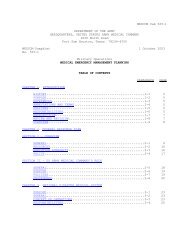(MCD) Guidelines
(MCD) Guidelines
(MCD) Guidelines
You also want an ePaper? Increase the reach of your titles
YUMPU automatically turns print PDFs into web optimized ePapers that Google loves.
<strong>Guidelines</strong> for Military Mass Casualty Decontamination Operations<br />
During a Domestic HAZMAT/Weapon of Mass Destruction Incident<br />
• Deceased (Black Triage Tag). Casualty unlikely to survive given severity of<br />
injuries, level of available care, or both. Palliative care and pain relief should be<br />
provided.<br />
• Immediate (Red Triage Tag). Casualty can be helped by immediate intervention<br />
and transport. Requires medical attention within minutes for survival (up to 60).<br />
Casualty’s airway, breathing, and circulation have been compromised.<br />
• Delayed (Yellow Triage Tag). Casualty’s transport can be delayed. Has serious<br />
and potentially life-threatening injuries, but status not expected to deteriorate<br />
significantly over several hours.<br />
• Minor (Green Triage Tag). Casualty has relatively minor injuries. Status unlikely<br />
to deteriorate over days. May be able to assist in own care. Also known as<br />
walking wounded.<br />
To identify casualties in the different triage categories, affix a commercially available<br />
triage tag to each casualty. The commercially available tags are perforated for easy<br />
ripping. The bottom-most color of the tag indicates the triage category of the<br />
casualty. Some tags may also have barcoded strips that can be detached and<br />
included in a bag of personal effects or retained by the Triage Officer. The barcodes<br />
make tracking, documentation, and accountability processes easier for casualty<br />
management.<br />
To separate the Triage Staging Area within the <strong>MCD</strong> corridor, lay colored tarps on<br />
the ground or place small colored flags in an area. Direct or place the casualties<br />
accordingly. The colors of the tarps and/or flags should correlate to the triage<br />
categories of Red, Yellow, Green, and Black. 2<br />
8.1.10. Treatment Versus Decontamination<br />
INTENT: Determine which casualties should receive treatment before they receive<br />
decontamination.<br />
Most medical treatment is delivered in the cold zone, after<br />
decontamination has occurred and been verified.<br />
However, in some cases, advanced-level skills are<br />
needed in the warm or hot zone before or during<br />
decontamination activities. In such a situation, the need<br />
for life-saving care should be weighed against the need to<br />
remove the contaminant.<br />
Before giving medical care, consider the nature and<br />
severity of the incident, the medical resources available,<br />
the resource requirements of providing such treatment,<br />
and the need to perform decontamination. 54 A casualty’s<br />
<strong>MCD</strong> Principles for<br />
Treatment Vs. Decon<br />
DHS UTL Tasks<br />
• ResB2b 6.1 and 6.2<br />
• ResC1a 5.1, 6.1, 6.2,<br />
6.2.1, 6.2.2, 6.2.3, and<br />
6.3<br />
USACBRNS Tasks<br />
• 03-2-5124 Step 19<br />
• 03-2-6593 Step 2a<br />
chance of survival increases exponentially if he/she reaches medical care within the<br />
first 60 minutes after the injury, sometimes referred to as the “golden hour.”<br />
42 Original



